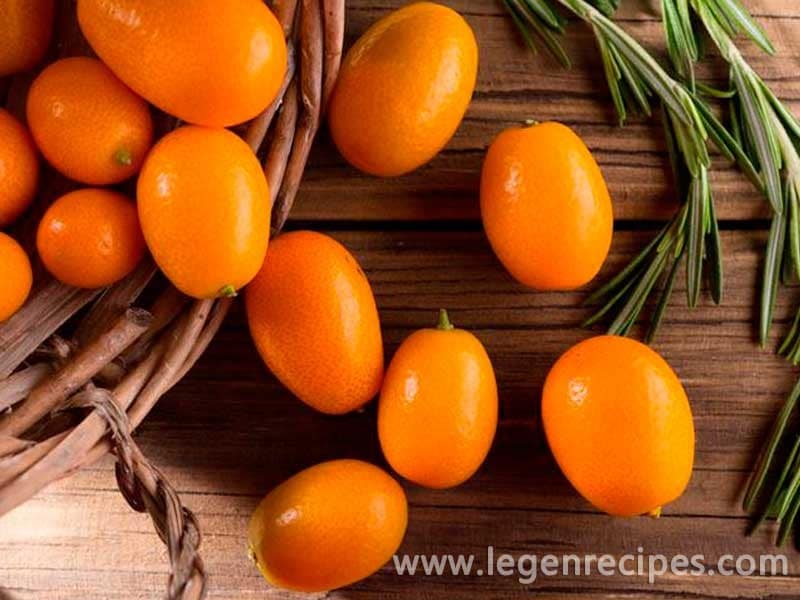Kumquat, kinkala, fortunella Chinese mandarins – it’s the name of the same fruit, the smallest citrus fruit in the world. The length of the oval-shaped fruit bright orange four centimeters, not more, and in cross-section – only two!
Homeland kumquats considered China (the southern provinces, the district of Guangzhou), where they grow several types of citrus fruits and their common name “kumquat” comes from the South Chinese dialect and means “golden orange.” Fortunella – low tree with a beautiful glossy foliage and incredibly fragrant flowers. These miniature trees are perfectly suited for apartment life (they just conventional flowerpot). And of course the culinary life.
Unlike other citrus fruits kumquats not clean, and eat whole, because they have thin skins, tender and sweet (albeit a little gorchaschaya), but the flesh is sour and not very juicy.
Useful properties kumquat long been proven and recognized. Since ancient times, healers have used the East its healing qualities for the treatment of various diseases: in the fetus good antibacterial properties. Kumquat rind contains a large number of essential oils with antibacterial properties. Therefore, residents of Asian countries often put kumquat peel next to the fire: Inhalation of vapors skin treat coughs and colds. Kumquat contains a large number furakumarina having strong antifungal activity, so the fruit is often used to treat fungal diseases. Like other citrus fruits, kumquat is able to activate the activity of the gastrointestinal tract, reducing blood cholesterol levels, help fight depression, fatigue and apathy, relieves tension. Kumquat, among other things, has immunostimulatory properties and helps the body adapt to adverse environmental conditions. In addition, the East kumquat fruits are very popular as a means of relieving hangover: the morning after the evening feast enough to eat a couple of these wonderful fruits – and the hangover will be over.
The types and grades
Currently kumquat spread to almost every country with a subtropical climate. It is grown in China, Japan, South and South-East Asia, Israel, the United States (Florida), southern Europe (in Greece), Africa, Australia, and even in the south of Russia (Krasnodar Territory) and Georgia . So the first thing to look for when buying a kumquat – where he came into the store or on the market.
In nature, it found six species of kumquat, different form of the fetus:
- Hong Kong kumquat (Fortunella hindsii) – the fruit of a circular shape, the smallest of all and the most delicious pulp;
- Malay kumquat (Fortunella polyandra) – the fruit of round shape, 2-3 cm in width;
- Marum kumquat, he also Morgagni kumquat (Fortunella japonica) – the fruit of a round, flattened or oval;
- Naga kumquat (Fortunella margarita) – the fruit of oval form; it has several varieties, for example, bred in 1965 Nordmann (Nordmann Seedless) or derived in 1986 petrolistny kumquat (Centennial variegated kumquat), the fruits of which in an immature form of stripes;
- Maeve kumquat (Fortunella crassifolia), which is considered a natural hybrid between Nagas and kuskvatami Marum – with large (up to 4 cm in diameter) round shaped fruits often;
- Fukushi kumquat, he’s Jiangsu kumquat (Fortunella obovata) – Fruits are large (up to 5 cm in diameter) than other varieties, oval or pear-shaped.
Kumquat often forms hybrids (natural and artificial) with other types of citrus poetomuvo many cases it is impossible to say definitely before us pure product or hybridized. Additional hybrids are known, for example, as follows:
There are hybrids with other citrus kumquat:
- Ichangkvat (Citrus ichangensis x Fortunella sp.) – lemon and kumquat ichansky
- Calamondin (Citrus reticulata x Fortunella margarita) – tangerine and kumquat naga
- Kumandarin (Citrus reticulata x Fortunella sp.) – tangerine and kumquat
- Limequat (Citrus aurantiifolia x Fortunella sp.) – lime and kumquat
- Lemonkvat (Citrus limon x Fortunella sp.) – lemon and kumquat
- Oranzhekvat (Citrus unshiu x (F. japonica x F. margarita)) – satsumas and kumquats
- Tsitranzhkvat ((C. sinensis x P. trifoliata) x Fortunella sp.) – tsitranzh (a hybrid of orange and citrus trifoliaty, also known as pontsirus trёhlistochkovy) and kumquat
- Tsitrumkvat (Poncirus trifoliata x Fortunella sp.) – trifoliata (pontsirus trёhlistochkovy) and kumquat
- Doll, Kucle ((C. deliciosa x C. salicifolia) x Fortunella margarita) – Clementine (hybrid of mandarin and orange) and Naga kumquat
- Prosaymkvat, Procimequat ((C. aurantiifolia x Fortunella sp.) x Fortunella hindsii) – Hong Kong kumquat and Limequat
How to cook
Unlike other citrus fruits kumquats not clean, and eat whole, because they have thin skins, tender and sweet, but the flesh is sour and not very juicy.
However, kumquats are good not only in raw form. They make wonderful candied fruits, jams and preserves from kumquats make excellent syrups, tinctures and liqueurs.
But this, of course, not all of the kumquats out delicious sauces for pork and chicken, and if you add a handful of kumquats mutton, you will have a unique taste of the dish. Caramelized kumquats can be mixed with rice and stuff the duck them. Circles kumquats as well putting in fruit salads and even cocktails: they are not only decorative, but also pleasantly flavored drinks and desserts. And from the “Golden Orange” is a refreshing ice cream and tonic sorbet, especially if add a little champagne.
Kumquat is good as a gift: the ladies can be presented with a golden jar of jam, and men – kumquats in cognac. Fruits preserved in alcohol recipe is simple: you have to boil the kumquats in syrup just three minutes to fill their jars and pour brandy Vostan syrup (1: 1), stir and pour over the fruit.
Season
Depending on the type of kumquat fruits ripen from late autumn to late winter. On the tree, they remain for several months, so that fresh kumquats some varieties can be harvested until March.
In the Southern Hemisphere season kumquat coincides with our summer and autumn, the fruit can be harvested from June to October.
How to choose and store
Fruit peel should be shiny, smooth and undamaged. The fruit should have a smooth color.
The rind tasty all kinds of kumquat (See above.) As for the flesh, it is believed that she had the most delicious Hong Kong kumquat.
Kumquat can be stored in the refrigerator up to 3 weeks.




